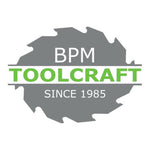
Choosing the right saw blade - getting it wrong can cost more than money!
Choosing the right saw blade can be both frustrating and confusing. This is exacerbated by the fact that much of the information available on the internet and especially on YouTube refers to blades unavailable in South Africa. Diablo, for example, causes a great deal of consternation amongst woodworkers because this brand is unavailable outside North America.
On the face of it how hard can it be to choose a blade of the correct diameter with right bore and an appropriate number of teeth for the cutting task being performed?

Unfortunately there is more to blade choice than diameter, bore and tooth count. Table saws and circular saws use different blades to mitre saws and radial arm saws. Not only will the quality of the cut be affected but it can be an important safety consideration.
Helpfully many blade manufacturers provide a whole lot of useful information apart from the number of teeth, diameter and bore. It would come as no surprise that entry level saw blades do not provide as much information about tooth geometry and the which machines the blade is best suited. Understanding some of the guiding principles of blade choice becomes even more important now.
Alternating Tooth Bevel (ATB) is most common for combination and cross-cut blades while ripping blades tend not to be bevelled.

Ripping blade

Combination crosscut/ripping blade

Combination blade for mitre/radial arm saw
The example below indicates the materials for which the blade is suited, the kinds of saws for which they are designed as well as the kerf width (thickness of the teeth) and the rake and profile of the teeth.

This info sticker tells us that the blade has a 250mm diameter, thin kerf (2.8mm) and is designed for cutting aluminium with a mitre saw. The tooth hook angle is -5⁰ and the grind is a High-Low Triple Chip Grind (HLTCG) where one flat-topped tooth is followed by a trapezoidal tooth that is slightly higher. The higher tooth precuts the material narrower than the final kerf, helping to eliminate chipping in brittle materials.

The kind of material being cut also affects blade choice. This can range from solid wood to composites, plywood, laminates, acrylics, aluminium, brass and even mild steel. Amazingly there are some multi-material blades, but these tend to be quite expensive and must make compromises in order achieve such versatility. Bear in mind that saws designed to cut steel run much slower than general purpose wood saws.
Good quality saw blades usually indicate with what kinds of saws they can be used. For example Freud, manufacturer of some of the best quality saw blades in world, has a very handy table on their website which lists blades appropriate for different materials as well the saws on which they can used. Helpful diagrams illustrate tooth profile and hook angle. (hook or rake is the “lean” of the tooth – positive hook teeth lean forward while negative hook teeth lean backward.) https://www.freudtools.com/public/catalog/freud-catalog/#page=16

Bosch also offers some useful advice on their local website.
https://www.bosch-professional.com/za/en/circular-saw-blades-2592810-ocs-ac/
Here are some general principles to keep in mind when choosing a saw blade:
- Few teeth with a flat profile and large gullet and large positive hook angle (often >15⁰) is best suited for ripping.
- Relatively larger number of teeth (50% more than a rip saw for the same size of blade) and a less aggressive hook angle (between 5⁰ and 15⁰) is suitable for both cross-cutting and ripping.
- Double the number of teeth of the same size rip-saw blade with a less aggressive positive hook angle – exclusively for cross-cutting solid wood, cutting laminates, aluminium and composites.
- Blades with 0⁰ to negative hook teeth are suitable for radial arm and mitre saws (there is some disagreement about this and there are some positive rake blades which are indicated as suitable for overhead saws). Negative hook angles tend to push the workpiece down onto the table. The Stumpy Nubbs YouTube Channel challenges some of the assumptions about tooth hook in this video: (https://www.youtube.com/watch?v=LTQolAMubMU&ab_channel=StumpyNubs).
- Thin kerf (<3mm) blades reduce the load on a saw’s motor which can be useful if you have a slightly underpowered saw. In addition less valuable timber is turned into sawdust, however the smaller size of the teeth makes them more vulnerable to damage, limits the extent to which they can be resharpened and also reduces feed rate.
- Blades with an anti-friction coating can help to prevent burning and extend blade life by reducing overheating.
- Most saw blades can be resharpened however this is dependent on the size and profile of the tungsten carbide tips. This should be considered when looking at the total cost of the blade. Often cheaper saw blades have smaller TCTs and can be sharpened fewer times.

Leave a comment